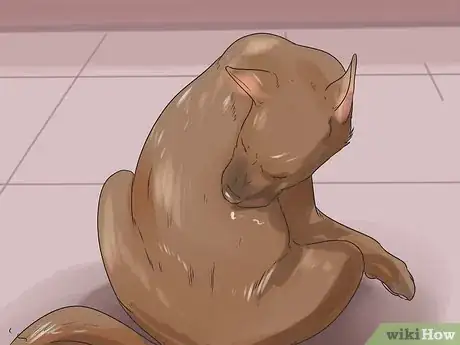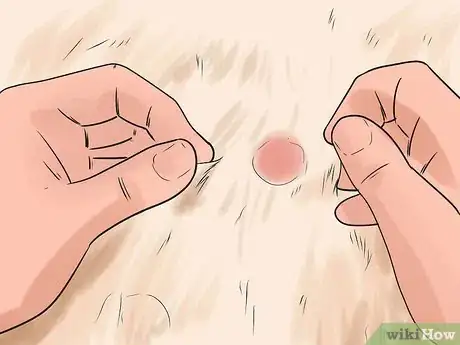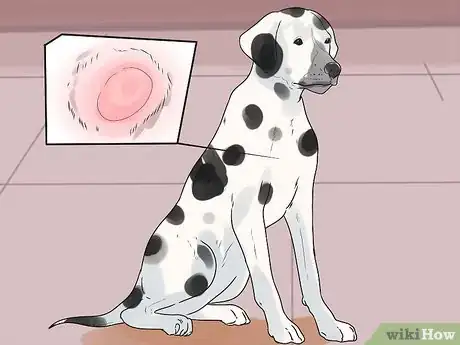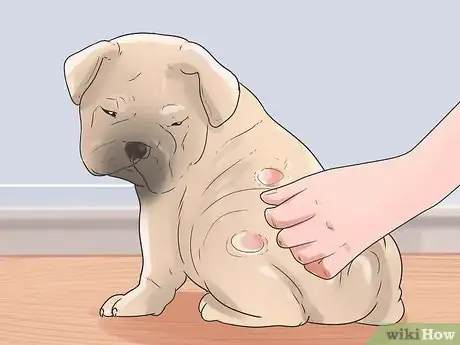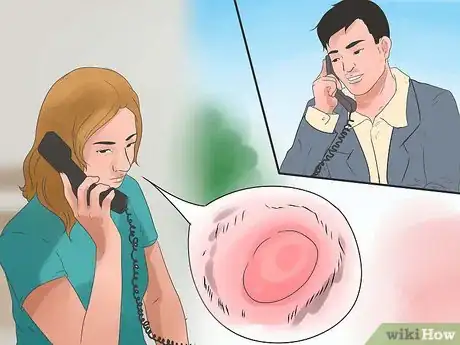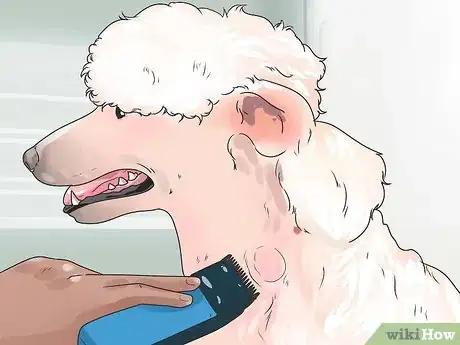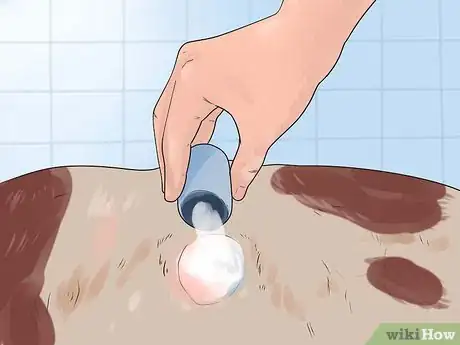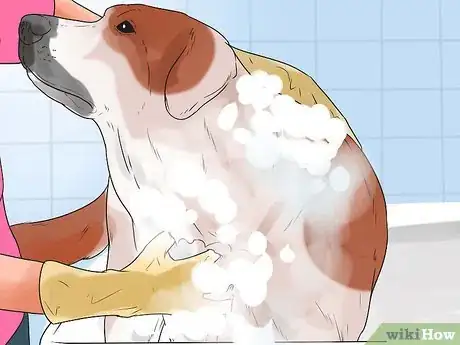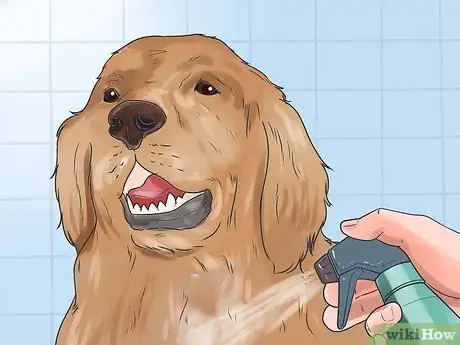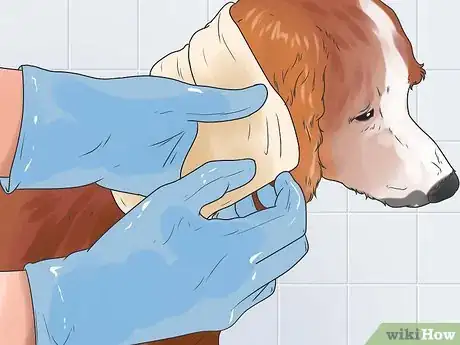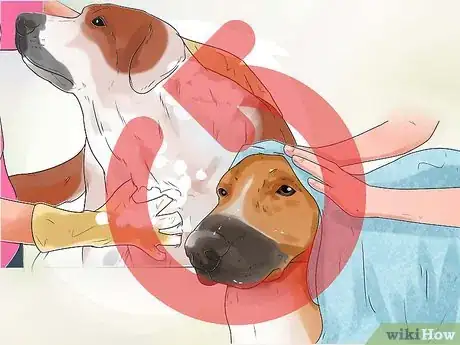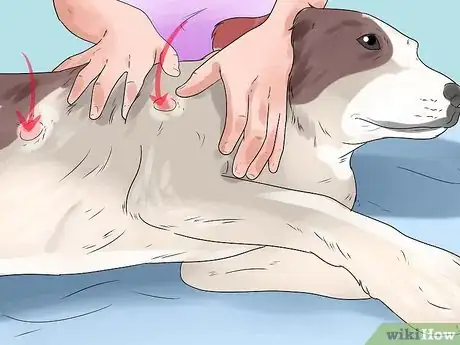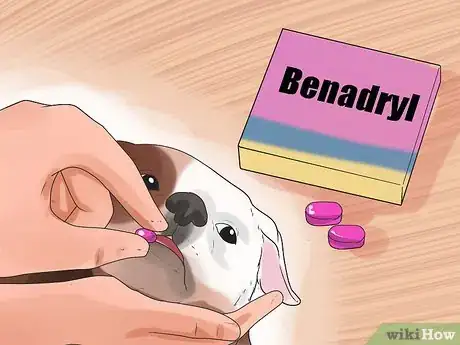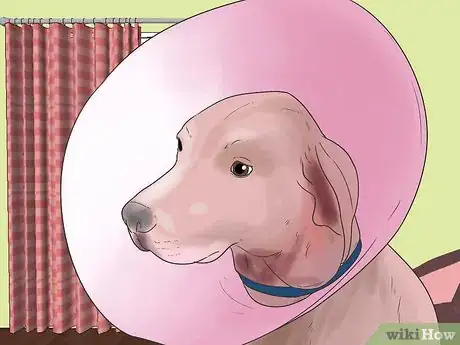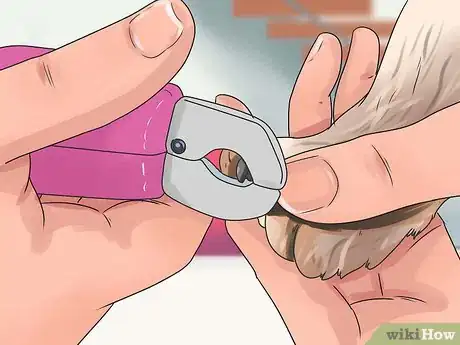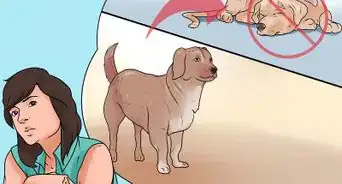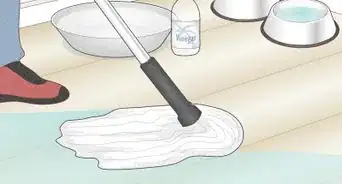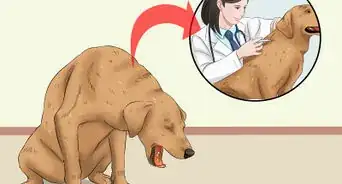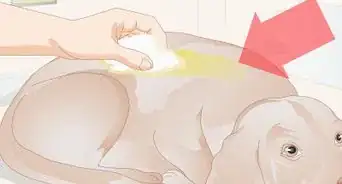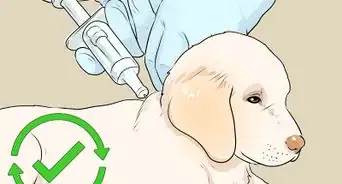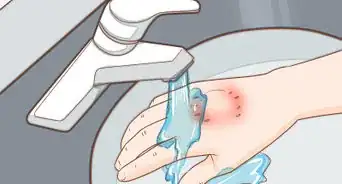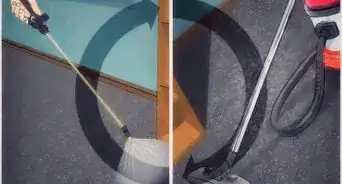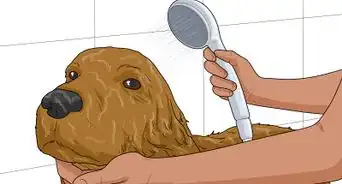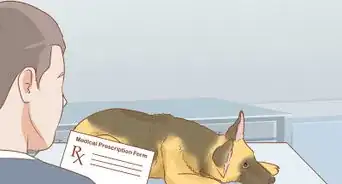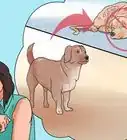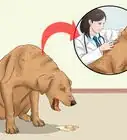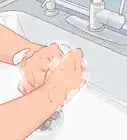This article was co-authored by Natalie Punt, DVM. Dr. Natalie Punt is a Veterinarian and the Founder and CEO of mPet- a smart phone app for pet owners to store, manage and transfer their pets medical records and health information. She specializes in small animal emergency and general medicine and veterinary practice economics. Dr. Punt holds a BS in Biochemistry and Molecular Biology from The University of California, Davis, an MS in Biochemistry from The University at Buffalo, and a DVM from Western University of Health Sciences.
There are 8 references cited in this article, which can be found at the bottom of the page.
wikiHow marks an article as reader-approved once it receives enough positive feedback. In this case, several readers have written to tell us that this article was helpful to them, earning it our reader-approved status.
This article has been viewed 411,276 times.
A hot spot, or what veterinarians term "acute moist dermatitis," is a painful and inflamed area of the skin that is often accompanied by discharge and a bad odor. Hot spots occur via allergic reactions to bacterial skin infections often caused by a lesion or wound. Skin breaks, lesions, and wounds can have a variety of causes, including flea bites, scratches, scrapes or nicks, anal gland problems, and underlying allergies. Dogs often itch and scratch skin breaks and wounds to such an extent that wet scabs form on the fur.[1] Hot spots can be painful for dogs and can become very large quite quickly. It is important to seek prompt and adequate treatment if you notice a hot spot on your dog.[2]
Steps
Identifying Hot Spots
-
1Watch your dog. Notice if your dog scratches or licks a particular spot constantly. This is usually a sign that he is suffering from some sort of skin irritation.
-
2Part and inspect your dog's fur. Examine more closely the problem area you have identified. Hot spots can be difficult to see with the naked eye because they tend to spread under the cover of the dog's fur. Usually by the time you notice them, hot spots are well established and growing rapidly. [3]Advertisement
-
3Identify that you are dealing with a hot spot. Hot spots are red, moist, hot and irritated rashes. Other identifiers of hot spots include discharge and an unpleasant odor.[5]
- Hot spots are commonly found on a dog's head, hip or chest area, but they can be found pretty much anywhere.
- Dogs with long hair and thick coats are most commonly affected.
- Dogs who are not groomed regularly and have matted coats are also prone to developing hot spots, as are dogs who swim or are frequently in the rain.[5]
- Dogs with hip dysplasia or anal sac disease are also more likely to suffer from hot spots because they tend to lick the skin on their hind end.[6]
-
4Check areas surrounding the hot spot. If you do identify a hot spot, take some time to carefully check the rest of the dog’s skin. Part the fur in the area surrounding the hot spot and examine for any other moist or reddened areas. All spots need to be treated immediately and, if possible, you should try to ascertain the underlying cause of the hot spot (flea bite, scratch, allergy, etc.).[9]
-
5Contact your vet. If this is your dog's first hot spot, seeing a vet is crucial. Your vet can give you an accurate diagnosis and develop an appropriate treatment plan.[8]
Cleaning the Affected Area
-
1Trim or clip the hair from the surface of the hot spot. Exposing the hot spot to air will dry out the moisture and help speed up the healing process. Be careful not to pull the hair, irritate the skin or cut your dog's skin.[12]
- Disinfect your scissors or clippers before clipping. In cases where there is a lot of discharge emerging from the hot spot, you will need to clean your clippers frequently while removing hair. Otherwise, the clippers will become plugged with debris. Remember to clean and disinfect the instrument after use.[13]
- Have your dog sit or lie down for this process. Get a second person if you need help keeping the dog still.
- To avoid accidentally cutting your dog's skin, don't cut too close to the skin itself and instead leave a quarter inch of stubble.[14]
- If the affected area is too large, shave it.[12]
-
2Clean the wound. Use an antimicrobial shampoo that you can purchase at a vet's office or a pharmacy for humans.[16]
-
3Leave the antimicrobial shampoo on the dog for 10 minutes. This will allow the medication in the shampoo to settle into the affected area and begin working. Rinse thoroughly after 10 minutes and dry the affected area completely.[20]
- If using an alternative solution, read and follow the accompanying instructions on how to apply.
-
4
-
5Keep the area dry. The air will help the wound heal more effectively, whereas more moisture will facilitate the wound's growth.
- Keep in mind that hot spots can't be covered with a bandage because this traps moisture in and thereby worsens the wound.[23]
-
6Inspect the wound twice daily. If there is a buildup of discharge, repeat the shampoo process (shampoo, rinse, dry) to keep the wound clean.[24]
-
7Check the dog’s entire body for any new or developing hot spots. This check should be done daily, particularly if it is hot or humid out.
Preventing Further Injury
-
1Stop the itch with an antibiotic. The best way to relieve itching is with an antibiotic prescribed by your vet. Your vet may prescribe a cream antibiotic that is applied directly to the skin in order to quickly and directly relieve the itching.
- Hydrocortisone spray can help reduce the irritation, but should not be used long term.
- Antihistamines such as Benadryl may also provide some relief. The appropriate dosage is 1 tablet per 50 pounds.
- Avoid putting creams intended for humans onto your dog's skin, as this can make matters worse. Creams keep moisture in the area, and the spot needs to dry completely before it can heal.
-
2Use an Elizabethan collar if your dog keeps licking or biting the lesions. The cone-shaped collar will restrain your dog's reach, making him unable to further irritate the wound.[25]
- An Elizabethan collar should not be used as the sole means of treatment for hot spots. Collars don't treat the hot spots but prevent your dog from making the lesions more severe. Untreated lesions will only grow and become more serious, in addition to being painful for your dog.[23]
- You can wrap a sock around one of the dog's rear feet and tape it into place if the hot spot can be scratched by a rear foot.
-
3Trim your dog's toenails. This keeps your dog from having a ready way to scratch the area and spread the infected discharge.[27]
Expert Q&A
Did you know you can get expert answers for this article?
Unlock expert answers by supporting wikiHow
-
QuestionCan I use coconut oil on my dog's hot spots?
 Pippa Elliott, MRCVSDr. Elliott, BVMS, MRCVS is a veterinarian with over 30 years of experience in veterinary surgery and companion animal practice. She graduated from the University of Glasgow in 1987 with a degree in veterinary medicine and surgery. She has worked at the same animal clinic in her hometown for over 20 years.
Pippa Elliott, MRCVSDr. Elliott, BVMS, MRCVS is a veterinarian with over 30 years of experience in veterinary surgery and companion animal practice. She graduated from the University of Glasgow in 1987 with a degree in veterinary medicine and surgery. She has worked at the same animal clinic in her hometown for over 20 years.
Veterinarian
-
QuestionWhat home remedy can I use for a hot spot on a dog?
 Pippa Elliott, MRCVSDr. Elliott, BVMS, MRCVS is a veterinarian with over 30 years of experience in veterinary surgery and companion animal practice. She graduated from the University of Glasgow in 1987 with a degree in veterinary medicine and surgery. She has worked at the same animal clinic in her hometown for over 20 years.
Pippa Elliott, MRCVSDr. Elliott, BVMS, MRCVS is a veterinarian with over 30 years of experience in veterinary surgery and companion animal practice. She graduated from the University of Glasgow in 1987 with a degree in veterinary medicine and surgery. She has worked at the same animal clinic in her hometown for over 20 years.
Veterinarian
-
QuestionIs apple cider vinegar good for dog hot spots?
 Pippa Elliott, MRCVSDr. Elliott, BVMS, MRCVS is a veterinarian with over 30 years of experience in veterinary surgery and companion animal practice. She graduated from the University of Glasgow in 1987 with a degree in veterinary medicine and surgery. She has worked at the same animal clinic in her hometown for over 20 years.
Pippa Elliott, MRCVSDr. Elliott, BVMS, MRCVS is a veterinarian with over 30 years of experience in veterinary surgery and companion animal practice. She graduated from the University of Glasgow in 1987 with a degree in veterinary medicine and surgery. She has worked at the same animal clinic in her hometown for over 20 years.
Veterinarian
Warnings
- It's a good practice to have your vet diagnose any and all skin rashes, abnormalities or wounds on your dog.⧼thumbs_response⧽
- In severe cases, hot spots can do serious damage to the skin of a dog. Though scarring is rare, it can sometimes be a consequence of hot spots.[27]⧼thumbs_response⧽
Expert Interview
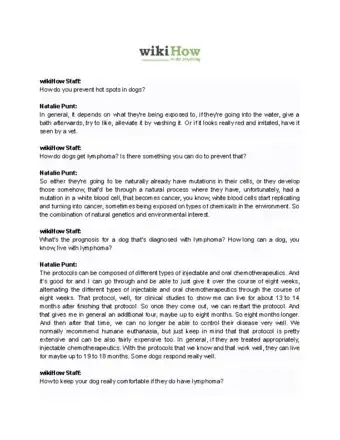
Thanks for reading our article! If you'd like to learn more about caring for dogs, check out our in-depth interview with Natalie Punt, DVM.
References
- ↑ http://www.petmd.com/dog/care/evr_hot_spots_what_are_they
- ↑ http://pets.webmd.com/dogs/what-hot-spots-dogs
- ↑ http://www.petmd.com/dog/care/evr_hot_spots_what_are_they
- ↑ Manual of Skin Diseases of The Dog and Cat. Sue Peterson. Blackwell Publishing. 2008.
- ↑ http://pets.webmd.com/dogs/what-hot-spots-dogs
- ↑ http://pets.webmd.com/dogs/what-hot-spots-dogs
- ↑ Clinical Medicine of the Dog and Cat, Second Edition. Edited by Michael Schae. Manson Publishing. 2010.
- ↑ http://pets.webmd.com/dogs/what-hot-spots-dogs
- ↑ Clinical Medicine of the Dog and Cat, Second Edition. Edited by Michael Schae. Manson Publishing, 2010.
- ↑ Clinical Medicine of the Dog and Cat, Second Edition. Edited by Michael Schae. Manson Publishing, 2010.
- ↑ Clinical Medicine of the Dog and Cat, Second Edition. Edited by Michael Schae. Manson Publishing, 2010.
- ↑ http://www.petmd.com/dog/care/evr_hot_spots_what_are_they
- ↑ Clinical Veterinary Advisor Dogs and Cats, Third Edition. Etienne Cote. Mosby. 2015.
- ↑ Clinical Veterinary Advisor Dogs and Cats, Third Edition. Etienne Cote. Mosby. 2015.
- ↑ http://www.petmd.com/dog/care/evr_hot_spots_what_are_they
- ↑ Clinical Veterinary Advisor Dogs and Cats, Third Edition. Etienne Cote. Mosby. 2015.
- ↑ Clinical Veterinary Advisor Dogs and Cats, Third Edition. Etienne Cote. Mosby. 2015.
- ↑ http://www.petmd.com/dog/care/evr_hot_spots_what_are_they
- ↑ Clinical Veterinary Advisor Dogs and Cats, Third Edition. Etienne Cote. Mosby. 2015.
- ↑ Clinical Veterinary Advisor Dogs and Cats, Third Edition. Etienne Cote. Mosby. 2015.
- ↑ Clinical Veterinary Advisor Dogs and Cats, Third Edition. Etienne Cote. Mosby. 2015.
- ↑ Clinical Veterinary Advisor Dogs and Cats, Third Edition. Etienne Cote. Mosby. 2015.
- ↑ http://pets.webmd.com/dogs/what-hot-spots-dogs?page=2
- ↑ Clinical Veterinary Advisor Dogs and Cats, Third Edition. Etienne Cote. Mosby. 2015.
- ↑ http://pets.webmd.com/dogs/what-hot-spots-dogs
- ↑ Kirk and Bistner’s Handbook of Veterinary Procedures and Emergency Treatment. Eighth Edition. Ford and Mazzaferro. Elsevier, Inc. 2006.
- ↑ http://www.petmd.com/dog/care/evr_hot_spots_what_are_they
About This Article
To treat hot spots in dogs, start by clipping the hair from the surface of the hot spot to expose it to air and dry out the moisture. Next, use an antimicrobial shampoo to clean the area, allowing the soap to set for 10 minutes before rinsing off. Once the dog is clean, have your vet recommend an antibiotic ointment or spray. While the area heals, keep it dry, clean, and unbandaged so no moisture collects around it. For more tips from our Veterinarian reviewer, including how to stop the itching for your dog, keep reading!
